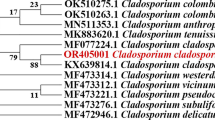Abstract
The aquatic hyphomycete Heliscus lugdunensis belongs to a group of exclusively aquatic mitosporic fungi with an only scarcely explored potential to oxidatively attack xenobiotic compounds, and was used to study the biotransformation of the environmental pollutant metabolite 1-naphthol. H. lugdunensis metabolized approximately 74% of 1-naphthol within 5 days. The identification and quantification of degradation products using gas chromatography-mass spectrometry, liquid chromatography-mass spectrometry, and high performance liquid chromatography revealed that approximately 12% of the parent compound was converted into 1-naphthylsulfate, 3% was transformed into 1-methoxy-naphthalene, and less than 1% was converted into 1,4-naphthoquinone. A further metabolite, most likely 4-hydroxy-1-naphthylsulfate, was also detected. In contrast to sulfate conjugate metabolites, no glucuronide and glucoside conjugates of 1-naphthol were found, and neither UDP-glucuronyltransferase nor UDP-glucosyltransferase present in H. lugdunensis showed activity towards 1-naphthol. These results support a role of fungi adapted to aquatic environments in affecting the environmental fate of pollutants in aquatic ecosystems.


Similar content being viewed by others
Literature Cited
Allen CCR, Boyd DR, Larkin MJ, Reid KA, Sharma ND, Wilson K (1997) Metabolism of naphthalene, 1-naphthol, indene, and indole by Rhodococcus sp. strain NCIMB 12038. Appl Environ Microbiol 63:151–155
Bärlocher F (1992) The ecology of aquatic hyphomycetes. Berlin: Springer-Verlag
Boss B, Richling E, Herderich M, Schreier P (1999) HPLC-ESI-MS/MS analysis of sulfated flavour compounds in plants. Phytochemistry 50:19–225
Cerniglia CE, Sutherland JB, Crow SA (1992) Fungal metabolism of aromatic hydrocarbons. In: Winkelmann G (ed) Microbial degradation of natural products. Weinheim: Wiley-VCH, pp 193–217
Da Silva M, Esposito E, Moody JD, Canhos VP, Cerniglia CE (2004) Metabolism of aromatic hydrocarbons by the filamentous fungus Cyclothyrium sp. Chemosphere 57:943–952
Dalton SA, Smith KA (1971) DDT and river fungi. Trans Br Mycol Soc 58(suppl):28
Dikshith TS, Kumar SN, Raizada RB, Srivastava MK, Ray PK (1990) Residues of 1-naphthol in soil and waters amples in and around Bophal, India. Bull Environ Contam Toxicol 44:87–91
Gosselin H, Hodge C, Smith RP, Gleason MN (1976) Clinical toxicology of commercial products. Baltimore: Williams & Wilkins
Hayatsu M, Hirano M, Nagata T (1999) Involvement of two plasmids in the degradation of carbaryl by Arthrobacter sp. strain RC100. Appl Environ Microbiol 65:1015–1019
Heitkamp MA, Freeman JP, Cerniglia CE (1987) Naphthalene biodegradation in environmental microcosms: estimates of degradation rates and characterization of metabolites. Appl Environ Microbiol 53:129–136
Johnsen AR, Wick LY, Harms H (2005) Principles of microbial PAH-degradation in soil. Environ Pollut 133:71–84
Junghanns C, Moeder M, Krauss G, Martin C, Schlosser D (2005) Degradation of the xenoestrogen nonylphenol by aquatic fungi and their laccases. Microbiology 151:45–57
Krauss G, Bärlocher F, Krauss G-J (2003) Effect of pollution on aquatic hyphomycetes. In: Tsui CKM, Hyde KD (eds) Freshwater mycology. Fungal diversity research series 10. Hong Kong: Fungal Diversity Press, pp 211–230
Krauss G, Bärlocher F, Wennrich R, Glässer W, Krauss G-J (2001) Aquatic hyphomycetes occur in hyperpolluted waters in Central Germany. Nova Hedwigia 72:419–428
Krauss G, Schlosser D, Krauss G-J (2005) Aquatic fungi in heavy metal and organically polluted habitats. In: Deshmukh SK, Rai MK (eds) Biodiversity of fungi: Their role in human life. New Dehli: Oxford & IBH Publishing Co Pvt Ltd, and Enfield: Science Publishers, pp 221–246
Lange B, Kremer S, Sterner O, Anke H (1994) Pyrene metabolism in Crinipellis stipitaria: identification of trans-dihydro-4,5-dihydroxypyrene and 1-pyrenylsulfate in strain JK364. Appl Environ Microbiol 60:3602–3606
Larson SJ, Capel PD, Majewski MS (1997) Pesticides in surface waters: distribution, trends, and governing factors. Chelsea: Ann Arbor Press
Lowry DH, Rosenbrough NJ, Farr AL, Randell RL (1951) Protein measurement with Folin phenol reagent. J Biol Chem 193:265–275
Sack U, Heinze TM, Deck J, Cerniglia CE, Cazau MC, Fritsche W (1997) Novel metabolites in phenanthrene and pyrene transformation by Aspergillus niger. Appl Environ Microbiol 63:2906–2909
Samanta SK, Chakraborti AK, Jain RK (1999) Degradation of phenanthrene by different bacteria: evidence for novel transformation sequences involving the formation of 1-naphthol. Appl Microbiol Biotechnol 53:98–107
Watanabe HK, Hoskins B, Ho IK (1986) Selective inhibitory effect of organophosphates on UDP-glucuronyltransferase activities in rat liver microsomes. Biochem Pharmacol 35:455–460
Wunder T, Marr J, Kremer S, Sterner O, Anke H (1997) 1-Methoxypyrene and 1,6-dimethoxypyrene: two novel metabolites in fungal metabolism of polycyclic aromatic hydrocarbons. Arch Microbiol 167:310–316
Zhang D, Yang Y, Leakey JEA, Cerniglia CE (1996) Phase I and phase II enzymes produced by Cunninghamella elegans for the metabolism of xenobiotics. FEMS Microbiol Lett 138:221–226
Acknowledgments
We thank C. Kuhnt (Halle) for performing the GC-MS measurements.
Author information
Authors and Affiliations
Corresponding author
Rights and permissions
About this article
Cite this article
Augustin, T., Schlosser, D., Baumbach, R. et al. Biotransformation of 1-Naphthol by a Strictly Aquatic Fungus. Curr Microbiol 52, 216–220 (2006). https://doi.org/10.1007/s00284-005-0239-z
Received:
Accepted:
Published:
Issue Date:
DOI: https://doi.org/10.1007/s00284-005-0239-z




